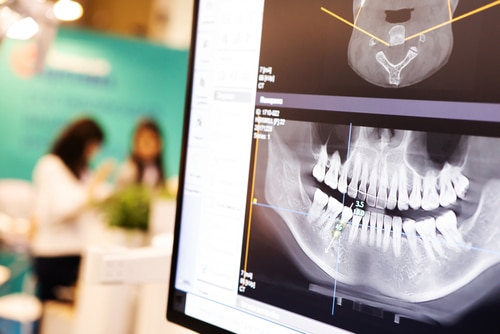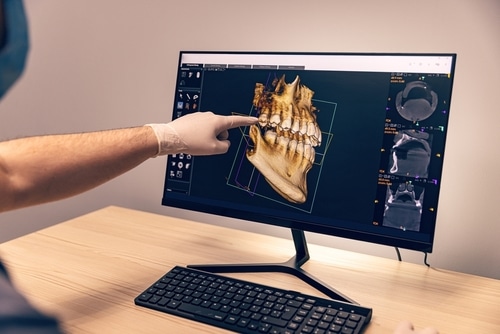Digital X-Rays in Emeryville, CA
Dr. Magno is passionate about staying up-to-date with the latest dental technology. As a lifetime student, she believes there is always more to learn and new ways to grow! Dr. Magno’s passion for dentistry fuels her dedication to providing patients with the best possible care. To ensure high-quality service, she has invested in advanced technology for her dental practice, including digital X-rays.
At San Francisco East Bay Mini Dental Implants, we use innovative X-ray technology, like CBCT scanning, to better treat patients like you! With a dedication to the best that modern dentistry has to offer, you can trust our team to provide exceptional dental care.
Understanding Digital X-Rays
The primary difference between traditional X-rays and digital X-rays is how we capture and process the images. Traditional X-rays use film to develop pictures of your oral structures, while digital X-rays use advanced sensors to create high-quality images instantly.
Consider these important differences between the two imaging approaches:
 Radiation: Traditional X-rays use more radiation to create an image. In contrast, digital X-rays reduce radiation risks, providing an overall safer approach.
Radiation: Traditional X-rays use more radiation to create an image. In contrast, digital X-rays reduce radiation risks, providing an overall safer approach.- Speed: Because they use film and chemical processing, traditional X-rays take longer to develop and process. Digital X-rays produce images almost instantly, negating the normal wait time associated with older X-ray technology.
- Analysis: Due to their digital nature, Dr. Magno can zoom in, adjust the color, and create a more detailed analysis of your mouth with these images. A digital X-ray allows her to better understand your problem and which treatments you may need.
- Storage: Traditional X-rays use physical film to capture images, creating storage challenges. Digital X-rays store images electronically, allowing for easy access and more efficient sharing with the patient and other healthcare providers if necessary.
What Is a CBCT?
Most dental practices nowadays have digital X-rays, but only a fraction have access to on-site CBCT machines. While digital X-rays can create useful two-dimensional images, they pale in comparison to the accuracy and detail of three-dimensional CBCT scans.
 CBCT stands for cone-beam computed tomography, an imaging technique that utilizes cone-shaped X-rays to create high-resolution 3D images. This machine is specifically used to aid in dental procedures, whether restorative or cosmetic. It is designed to develop an in-depth 3D model of your smile for a dentist like Dr. Magno to examine thoroughly.
CBCT stands for cone-beam computed tomography, an imaging technique that utilizes cone-shaped X-rays to create high-resolution 3D images. This machine is specifically used to aid in dental procedures, whether restorative or cosmetic. It is designed to develop an in-depth 3D model of your smile for a dentist like Dr. Magno to examine thoroughly.
With a CBCT, Dr. Magno can see the intricacies of your smile and accurately evaluate dental issues. This innovative technology allows Dr. Magno to assess jaw width and height, identify cavities, locate root canals, evaluate bone loss, and more! With this diagnostic information, she can plan how to treat your dental problem most effectively.
Cone beam X-rays play a vital role in implant dentistry, a procedure used to replace missing teeth. A CBCT scan is essential for any dental implant treatment, as it allows Dr. Magno to thoroughly assess your jawbone and precisely plan implant placement. This advanced technology enables her to deliver exceptional care, ensuring patients leave her practice with confident, beautiful smiles!
Why CBCT Scans Are Essential for Mini Implants
To get a traditional dental implant, you must have enough space in your jaw. However, those with missing teeth may not qualify, as tooth loss leads to bone loss over time. Here’s how: When you lose a tooth, you also lose its root, or the part of the tooth’s structure underneath the gums. Tooth roots are embedded in your jawbone, stimulating it while you bite or chew. Without stimulation, the jawbone resorbs, losing mass and volume. Unfortunately, those with insufficient jawbones become ineligible for a dental implant or require a bone graft, which adds to the procedure’s length and price.
A CBCT allows Dr. Magno to asses your jawbone, determining how much bone you have available for dental implants. Those who don’t have enough space for a conventional-sized implant don’t need to worry since Dr. Magno offers mini dental implants. Mini dental implants are significantly smaller—less than 3 millimeters wide—and consist of only one piece! Their sleek design provides many incredible advantages, including requiring less bone.
When you come in for your consultation, Dr. Magno will take a CBCT scan to evaluate your bone quality and where to place your mini dental implants. Because they’re so narrow, Dr. Magno can make a tiny hole in your gums and jawbone and then screw the implant into place. With their small size and minimally invasive procedure, mini implants are much more accessible than traditional ones. Most people have enough jawbone to support a narrow-diameter implant and can undergo the gentler placement procedure.
After Dr. Magno places your mini implants, she’ll attach a temporary restoration the same day, allowing you to walk out of our practice with a confident smile!
Experience the Benefits of Innovative Digital X-Rays
Dr. Magno is committed to delivering the highest-quality dental care to her patients. By staying at the forefront of innovation and using the latest X-ray technology, she can achieve the best results. With her state-of-the-art CBCT scanner, Dr. Magno thoroughly evaluates your smile and designs a personalized treatment plan tailored to your needs.
Ready to experience the benefits of innovative digital X-rays? Contact us today to experience outstanding care with cutting-edge technology!
Frequently Asked Questions
Digital X-rays are as safe as any other X-ray technology and even more so than traditional film X-ray technology. While Dr. Magno only uses this technology when necessary, it is a great tool in dentistry that helps patients like you receive the treatment they need.
As with any X-ray technology, there is minor radiation exposure involved. However, the benefits of using an X-ray like the CBCT far outweigh the risks when it comes to taking care of your health!
A CBCT scan takes less than a minute! The process is simple and quick, allowing us to get precise images quickly. In just a short time, we can generate a 3D, high-quality rendering of your smile!
Dental X-rays, like all medical X-rays, should only be done when necessary. While the radiation dose from dental X-rays is minimal and considered safe, it’s still wise to limit unnecessary exposure. It is important to always listen to a medical professional for advice about X-rays.
RELATED VIDEOS
- What Is a CBCT?
- What Is a Dental Implant?
- What Is a Mini Dental Implant?
- Dental Implants vs Mini Dental Implants
- Can I Get An Extraction and an Implant at the Same Time?
- What If I Don’t Have Enough Bone For a Dental Implant?
- What Is a Dental Bone Graft?
- What Kinds of Issues Can Mini Dental Implants Fix?
- Options For Replacing a Single Tooth
- Options For Replacing All My Teeth
- The Mini Dental Implant Process Explained
- What Can I Eat After Dental Implant Treatment?
- How Does Gum Disease Affect Dental Implants?
- Denture Options
- What Is an Implant Denture?
- What Is All-on-4?
- What Is a Fix-On-Six?
- What Is an Snap-On Denture?
- What Is a Fixed Bridge?
- How Many Implants Do I Need?
- How Do I Care For My Implant Denture?
